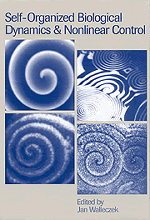 Self-Organized Biological Dynamics and Nonlinear Control
Self-Organized Biological Dynamics and Nonlinear Control Book contents
- Frontmatter
- Contents
- List of contributors
- Preface
- The frontiers and challenges of biodynamics research
- Part I Nonlinear dynamics in biology and response to stimuli
- 1 External signals and internal oscillation dynamics: principal aspects and response of stimulated rhythmic processes
- 2 Nonlinear dynamics in biochemical and biophysical systems: from enzyme kinetics to epilepsy
- 3 Fractal mechanisms in neuronal control: human heartbeat and gait dynamics in health and disease
- 4 Self-organizing dynamics in human sensorimotor coordination and perception
- 5 Signal processing by biochemical reaction networks
- Part II Nonlinear sensitivity of biological systems to electromagnetic stimuli
- Part III Stochastic noise-induced dynamics and transport in biological systems
- Part IV Nonlinear control of biological and other excitable systems
- Index
3 - Fractal mechanisms in neuronal control: human heartbeat and gait dynamics in health and disease
Published online by Cambridge University Press: 14 August 2009
- Frontmatter
- Contents
- List of contributors
- Preface
- The frontiers and challenges of biodynamics research
- Part I Nonlinear dynamics in biology and response to stimuli
- 1 External signals and internal oscillation dynamics: principal aspects and response of stimulated rhythmic processes
- 2 Nonlinear dynamics in biochemical and biophysical systems: from enzyme kinetics to epilepsy
- 3 Fractal mechanisms in neuronal control: human heartbeat and gait dynamics in health and disease
- 4 Self-organizing dynamics in human sensorimotor coordination and perception
- 5 Signal processing by biochemical reaction networks
- Part II Nonlinear sensitivity of biological systems to electromagnetic stimuli
- Part III Stochastic noise-induced dynamics and transport in biological systems
- Part IV Nonlinear control of biological and other excitable systems
- Index
Summary
Introduction
Clinical diagnosis and basic investigations are critically dependent on the ability to record and analyze physiological signals. Examples include heart rate recordings of patients at high risk of sudden death (Figure 1), electroencephalographic (EEG) recordings in epilepsy and other disorders, and fluctuations of hormone and other molecular signal messengers in neuroendocrine dynamics. However, the traditional bedside and laboratory analyses of these signals have not kept pace with major advances in technology that allow for recording and storage of massive data sets of continuously fluctuating signals. Surprisingly, although these typically complex signals have recently been shown to represent processes that are nonlinear, nonstationary, and nonequilibrium in nature, the tools to analyze such data often still assume linearity, stationarity and equilibrium-like conditions. Such conventional techniques include analysis of means, standard deviations and other features of histograms, along with classical power-spectrum analysis. An exciting recent finding is that such complex data sets may contain hidden information, defined here as information not extractable with conventional methods of analysis. Such information promises to be of clinical value (forecasting sudden cardiac death in ambulatory patients, or cardiopulmonary catastrophes during surgical procedures), as well as to relate to basic mechanisms of healthy and pathological function. Fractal analysis is one of the most promising new approaches for extracting such hidden information from physiological time series.
- Type
- Chapter
- Information
- Self-Organized Biological Dynamics and Nonlinear ControlToward Understanding Complexity, Chaos and Emergent Function in Living Systems, pp. 66 - 96Publisher: Cambridge University PressPrint publication year: 2000
- 52
- Cited by


